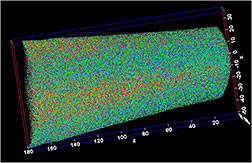- Number 411 |
- April 14, 2014
Researchers flock to radioactive materials microscopy suite

LEAP-produced this 3D reconstruction of
gold-implanted cerium oxide, a research
surrogate for nuclear fuel.
Two years after the Microscopy and Characterization Suite (MaCS) opened in the Center for Advanced Energy Studies at DOE's Idaho National Laboratory, the facility is booked solid. In fact, it has doubled the number of research hours logged in the last year.
The suite is open to external researchers and supports advanced microscopy for both radiological and nonradiological materials. National and international scientists from academia and private industry can access research tools here that will help answer some of today's most critical questions, especially with regard to nuclear materials science.
Users include research scientists from more than 10 universities in six states and one foreign country. Researchers from private industry, including Micron and Atomic Energy of Canada Limited, also are regular MaCS users.
The cutting-edge nature of the equipment in MaCS underlies its demand. In addition to being open to external researchers, the suite supports advanced microscopy for both radiological and nonradiological materials. The most sought-after equipment includes:
- The Focused Ion Beam (FIB): a focused beam of ions used to cut materials at the micro- and nanoscale. FIB can cut a sample smaller than 10 microns (the width of human hair is around 100 microns). This tool enables handling control and precise cutting of material, which is a huge benefit to scientists.
- The Transmission Electron Microscope (TEM): an electron microscope that can magnify up to 300 million times more than a glass-lens microscope. Researchers can study how radiation damage affects structure and chemistry in a material sample using this instrument at nanometer to atomic level.
- The Local Electrode Atom Probe (LEAP): a state-of-the-art instrument that analyzes materials in a real 3-D space at the atomic level. At this high resolution, researchers can study spatial relationships and chemical distributions of individual atoms during or after radiation.
The suite was made possible largely through a partnership with the Advanced Test Reactor National Scientific User Facility (ATR NSUF), which is based at INL. ATR NSUF competitively awards external researchers access to unique experiment irradiation and post-irradiation examination capabilities.
The success of MaCS demonstrates the benefits of collaboration and cross-institutional partnership within the global research community.[Nicole Stricker, 208.526.5955,
nicole.stricker@inl.gov]
